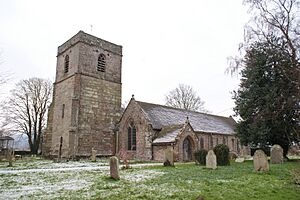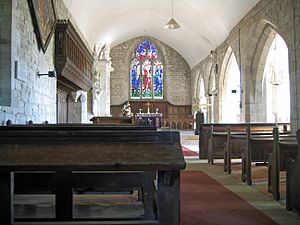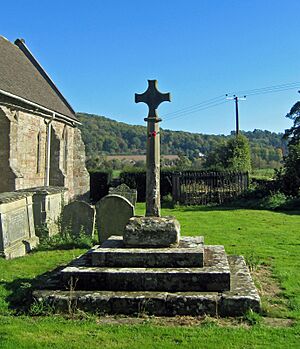St Cuthbert's Church, Holme Lacy facts for kids
Quick facts for kids St Cuthbert's Church, Holme Lacy |
|
|---|---|

St Cuthbert's Church, Holme Lacy, from the southwest
|
|
| Lua error in Module:Location_map at line 420: attempt to index field 'wikibase' (a nil value). | |
| OS grid reference | SO 568 347 |
| Location | Holme Lacy, Herefordshire |
| Country | England |
| Denomination | Anglican |
| Website | Churches Conservation Trust |
| History | |
| Dedication | Saint Cuthbert |
| Architecture | |
| Functional status | Redundant |
| Heritage designation | Grade I |
| Designated | 26 January 1967 |
| Architectural type | Church |
| Style | Gothic |
| Groundbreaking | 12th century |
| Completed | 16th century |
| Specifications | |
| Materials | Sandstone, tile roofs |
St Cuthbert's Church is an old Anglican church that is no longer used for regular services. It is located about 1.6 kilometers (1 mile) southeast of Holme Lacy village in Herefordshire, England. The church stands by itself at the end of a small road, right by a bend in the River Wye. It is a very important historical building, listed as Grade I, and is looked after by the Churches Conservation Trust.
Contents
History of St Cuthbert's Church
The land where St Cuthbert's Church stands was given to Walter de Lacy by William the Conqueror after the Norman conquest of England. Later, the land was passed down to the Scudamore family through marriage. They owned it until 1909–1910, when Sir Robert Lucas-Tooth bought it.
The Domesday Book, a famous survey from 1086, mentions a priest in Holme Lacy. This means there was likely a church here even back then. Today, the church is quite isolated, but old earthworks nearby suggest that a village once stood close by. This village was later abandoned.
The church building you see today was mostly built in the 13th century. The tower was added in the 14th century. In the 16th century, a north chapel and a south porch were built. Over the years, the church has had some changes. In 1833, a gallery was added, and an organ was put in. By 1924, the gallery was removed, and a new organ replaced the old one. During that year, the roof, arches, and floors were also repaired.
Architecture of the Church
St Cuthbert's Church is built from sandstone and has tiled roofs. It has a long main hall called a nave with a smaller area at the east end called a chancel. There is also a north chapel and a south aisle that leads to a south chapel. A south porch is at the entrance, and a tower stands at the west end.
Outside the Church
The tower has three levels, with a stone band separating the top two. It has strong diagonal supports called buttresses at its corners. On the west wall of the tower, there's an arched doorway with a small arched window above it. Higher up, there's another window, which is square. The top level of the tower has arched openings with wooden slats for the bells. Above each bell opening, there are two small windows shaped like three-leaf clovers. The top edge of the tower is flat.
Along the north wall of the nave, there are three pairs of windows. Above one pair, there's a small window with a pointed roof, called a dormer. The north wall of the chancel also has similar windows. The main east window of the chancel has three sections. There are various windows along the south wall, including two tall, narrow ones called lancet windows. The south porch has benches inside.
Inside the Church
The main parts of the church have plastered ceilings. However, the north chapel has an open, rounded ceiling that looks like the inside of a wagon. A beautifully carved wooden screen separates the nave from the north chapel.
Church Fittings and Furniture
You can find a piscina (a basin for washing communion vessels) in both the chancel and the south chapel. The baptismal font is from the 17th century. It has a round bowl on a cylindrical base, decorated with carved flowers and cherubs. Near the entrance to the north chapel, there's a round stone bowl on the floor.
The chancel has a communion table from the 17th century, and its east wall is covered with wooden panelling from the same time. The church also has two sets of choir stalls, possibly from the 15th century. These stalls have special seats called misericords, which are carved with interesting designs like a strange head and a bird. Other items from the 17th century include carved benches, a chest, and chairs.
The lectern (where readings are given) has a golden eagle on an oak stand, dated 1914. On the walls, there are four hatchments, which are diamond-shaped boards showing family coats of arms. Near the south door, there's a board from 1790 listing donations to the church.
At the west end of the church, there's a large organ. It was built in 1912 and moved to its current spot in 1924. The church has a set of eight bells. Six of these bells were made in 1709, and the other two were made in 1808 and 1829. All the bells were cast by Rudhall of Gloucester.
Memorials and Tombs
Most of the memorials in the church are for members of the Scudamore family. Between the chancel and the south chapel, there is a large stone tomb from around 1550. On top of it are carved figures (called effigies) of John Scudamore and his wife Sibell, made from alabaster (a soft, white stone). John Scudamore is shown in armor, with his feet resting on a lion. Sibell is wearing a long dress. The sides of the tomb have shields with family coats of arms.
On the north wall of the chancel, there is a white marble monument in the Baroque style for James Scudamore, who died in 1668. It features a sculpture of James Scudamore sitting, dressed in Roman-style clothing. Two cherubs are above his head, and the whole monument is framed by two flat columns called pilasters. To the left of this, there is another Baroque-style monument for his wife, Jane.
In the south aisle, there is a wall monument for James Scudamore, 3rd Viscount Scudamore, who died in 1716. This monument includes a stone coffin shape (a sarcophagus) with an urn (a decorative vase) and two seated cherubs on top. Below, on each side of the sarcophagus, are two skulls decorated with wreaths. The whole monument is surrounded by Ionic columns and a broken triangular top piece called a pediment.
On the east wall of the south chapel, there is a monument to Mary Scudamore Stanhope, who died in 1859. This was carved by Matthew Noble from white marble and shows a female figure standing in a carved space called a niche. In the north chapel, there is another marble wall monument by Noble. This one is for Chandos Scudamore Stanhope, a captain in the Royal Navy who died in 1871. It shows an angel above an anchor.
Stained Glass Windows
The stained glass in the east window of the south chapel shows Cornelius and an angel. It is a memorial to Francis Brydges Scudamore Stanhope, who died in 1855. In the east window of the chancel, there is a picture of the Archangel Michael weighing souls. This window remembers Sir Robert Lucas-Tooth, who died in 1915. The north window of the chancel has small pieces of medieval glass.
The east window on the south wall of the south aisle shows the Good Samaritan. This window is a memorial to William Pitt Scudamore Stanhope, who was the church's vicar from 1872 to 1892. In the north chapel, there is a window showing Sir Galahad and Sir Bors. This window remembers Sir Archibald Lucas-Tooth, 2nd Baronet, who died in the First World War in 1918. Also in the north chapel, there is a window remembering Henry Scudamore-Stanhope, 9th Earl of Chesterfield, who died in 1887.
Outside the Church Grounds
To the south of the church, there is a churchyard cross made of sandstone. The oldest parts, like the base and the lower part of the main pole, are probably from the 14th century. The three stone steps, the upper part of the pole, and the cross itself were added during a restoration in the 20th century. This cross is also a Grade II listed building.
Also to the south of the church, there are three other Grade II listed items. East of the porch, there is a wide grave headstone dated 1660. Further west, there are two pairs of chest tombs. The first pair is dated 1790 and 1847. The other pair is surrounded by railings and dates from around 1835.
To the east of the church, there is a gate with stone posts (called piers) and attached walls. The gate and piers are likely from the late 17th century, and the walls were added later. The gates and piers are made of wrought iron, and the walls are sandstone. The decorative arch above the gate (called an overthrow) has an inscription and a design that combines the Royal coat of arms with the Scudamore family's arms. This gate, its piers, and the walls are a Grade II* listed building. It is believed they were moved here from Holme Lacy House.
North of the church tower, there is a war grave for a Canadian Army soldier who died in World War I.
See also





